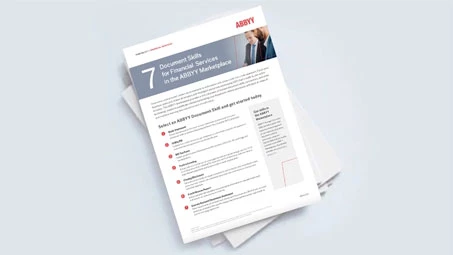
The healthcare payer industry is navigating a period of significant strain. Rising operational costs, persistent workforce gaps, and evolving member expectations are testing the limits of legacy systems and manual processes. To not only survive but thrive, payers must embrace smarter, more connected models built on advanced technology. The past year has made it clear that agile, data-driven strategies are no longer optional: they are essential for growth.
This post will explore the key challenges facing healthcare payers today and the technology trends that offer a path forward. We will examine why AI adoption is critical for staying competitive and dive into how intelligent document processing (IDP) combined with large language models (LLMs) is transforming core operations, from claims management to member services.
Jump to:
The healthcare payer industry in 2025
Top technology trends shaping the payer landscape
The imperative of AI for competitive advantage
Intelligent document processing and LLMs: A powerful combination
The healthcare payer industry in 2025
Healthcare payers, particularly small and midsize plans, face immense pressure. The global healthcare payer services market reached $35.5 billion in 2024 and is expected to grow, highlighting the increasing demand for solutions that enhance efficiency and reduce administrative burdens. The core challenges are multifaceted.
First, rising healthcare costs continue to squeeze margins. Payers are constantly searching for ways to deliver cost-effective care without compromising quality. Second, member expectations have shifted dramatically. Consumers now demand retail-like digital experiences with transparent pricing, intuitive navigation, and personalized engagement. Finally, the sheer volume of data and the complexity of regulatory compliance make manual processing an unsustainable model. These pressures are forcing a strategic shift toward technological innovation.
Top technology trends shaping the payer landscape
To address these challenges, forward-thinking payers are adopting several key technology trends. These innovations are not just about improving existing processes; they are about fundamentally rewiring how payers operate to deliver greater value.
1. Agentic AI and autonomous operations
AI agents are emerging as powerful tools for enhancing efficiency. These autonomous systems can proactively detect fraud, streamline underwriting, and personalize member engagement without constant human intervention. By automating repetitive, high-volume tasks, agentic AI frees up employees to focus on more complex, value-added activities. This reinvents operating models and boosts overall productivity.
2. The internet of medical things (IoMT)
The integration of IoMT and remote monitoring is reshaping chronic care management. Real-time biometric data from wearables and home-based devices enables early medical interventions, reduces costly hospital admissions, and supports more dynamic, personalized care models. For payers, this data provides valuable insights for risk assessment and proactive health management.
3. Enhanced data interoperability
Moving beyond regulatory mandates, payers are leveraging Fast Healthcare Interoperability Resources (FHIR) standards to create a seamless exchange of information. By integrating diverse data sources—clinical, financial, and even social determinants of health—payers can generate a comprehensive view of each member. This facilitates better care coordination, reduces duplicate testing, and accelerates processes like prior authorization.
4. Retail-like digital experiences
To meet modern consumer demands, payers are investing in creating "digital front doors" that mimic the user-friendly experiences of retail giants. This includes providing transparent pricing tools, simplified preservice coordination, and AI-powered virtual assistants that help members navigate their coverage. A superior digital journey is becoming a key differentiator for member acquisition and retention.
The imperative of AI for competitive advantage
While these trends are distinct, they share a common thread: artificial intelligence. Insurers that successfully integrate AI into their core functions are already outperforming their peers. Research shows that AI leaders in the insurance sector have generated significantly higher total shareholder returns than laggards.
But achieving a return on AI investments requires strategy. Success is a methodical process that demands focus and precision. To unlock AI’s transformative value, businesses must take a data-driven approach to identifying opportunities, accelerating improvements, and monitoring results.
Most organizations today focus their AI investments on personal productivity, deploying AI chatbots and copilots that have only a marginal impact on critical business outcomes. To unlock the full potential of AI, leading organizations are shifting their investments toward automating and scaling operations. This approach drives faster turnarounds, expands capacity, outpaces competitors, and boosts the bottom line.
Most organizations today focus their AI investments on personal productivity, deploying AI chatbots and copilots that have only a marginal impact on critical business outcomes. To unlock the full potential of AI, leading organizations are shifting their investments toward automating and scaling operations. This approach drives faster turnarounds, expands capacity, outpaces competitors, and boosts the bottom line.
Intelligent document processing and LLMs: A powerful combination
A significant portion of a payer's administrative workload involves processing documents—claims, medical records, enrollment forms, and explanations of benefits. Manual handling of this information is a major source of inefficiency, errors, and delays. Intelligent document processing (IDP) provides a powerful solution by automating the capture, extraction, and processing of data from any document format.
Unlike traditional OCR, IDP uses purpose-built AI to understand the context of a document. It can identify and extract key information with high accuracy, then validate it against business rules and export it to downstream systems. For payers, this technology can automate claims adjudication, streamline member onboarding, and ensure data integrity for compliance.
When IDP is combined with large language models (LLMs), its capabilities are amplified. IDP provides the factual, verified data that LLMs need to generate reliable and contextually aware outputs. This synergy creates a multiplier effect, enabling smarter automation and unlocking even greater value.
For example:
- Claims management: An IDP solution can extract data from complex medical records and claim forms. An LLM can then use this structured data to generate summaries of a patient's history, identify potential discrepancies, or draft communications to providers, dramatically accelerating the review process.
- Prior authorization: IDP can quickly process clinical documentation submitted by providers. An LLM can then analyze this information against the payer's policies to determine if a procedure meets the criteria for approval, providing a recommendation to a human reviewer in seconds.
- Member services: When a member calls with a question, an IDP-powered system can instantly pull up and analyze their policy documents. An LLM can then help the service agent formulate a clear, accurate, and empathetic response, improving the member experience.
By grounding LLMs in the structured, accurate data provided by IDP, payers can mitigate the risks associated with using generative AI for business-critical workflows and ensure their outputs are reliable.
Invest in an intelligent future
The healthcare payer industry is at a crossroads. The organizations that embrace AI and intelligent automation will be the ones that succeed in this new era. By strategically investing in technologies like AI, IoMT, and interoperability, payers can reduce costs, enhance the member experience, and improve care outcomes.
Intelligent document processing, particularly when combined with the power of LLMs, offers a clear path to transforming document-heavy workflows. It is more than a tool for efficiency; it is a strategic asset that turns information into accurate, process-ready intelligence. For payers ready to put their data to work, the future of competitive advantage lies in purpose-built AI solutions.





